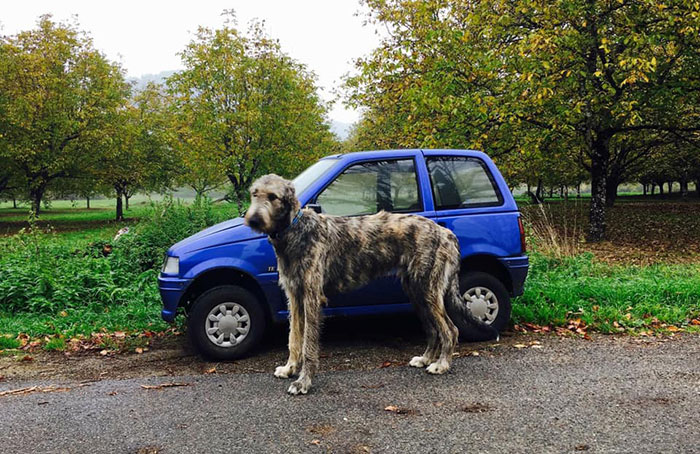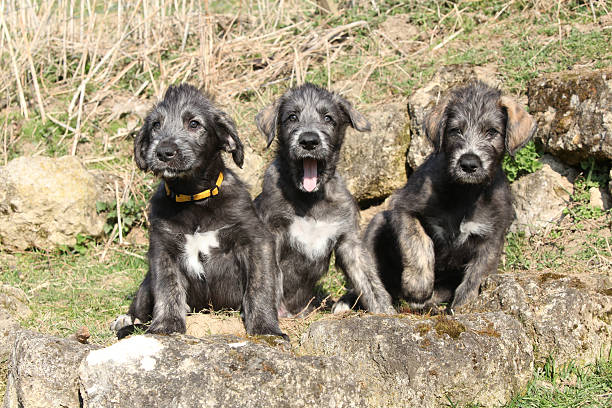Irish Wolfhound

Breed History:
The Irish Wolfhound is named for its original purpose rather than its place of origin—bred in Ireland, its roots trace back over a thousand years. These massive hounds were developed from ancient war dogs and crossed with large breeds like the Great Dane and Scottish Deerhound to hunt wolves and protect livestock.
Bred by Irish chieftains and nobility, their size and strength made them ideal for dragging men off horses and defending against predators. But by the 18th century, with wolves extinct in Ireland, the breed nearly vanished. Revival efforts in the 19th century, led by Captain George Augustus Graham, restored the Wolfhound’s numbers.
Soon after, the breed gained popularity beyond Ireland, admired for its imposing stature and gentle nature. Irish Wolfhounds found a place in American homes, not for battle or hunting, but as dignified and affectionate companions.
Considering adopting an Irish Wolfhound or a similar giant breed? Check out our page "How to look after a Great Dane" detailing what to consider before adopting and our recommended products for a Great Dane and other giant dog breeds.
|
Gender |
Height |
Weight |
|
Male |
79-86 cm |
50-55 kg |
|
Female |
71-80 cm |
40-45 kg |
Size – Giant
Life Expectancy: 10 to 12 years

Breed Appearance:
One of the tallest dog breeds, the Irish Wolfhound is known for its commanding size and rough, wiry coat that lies close to the body. Their double coat, usually gray, brindle, or wheaten, requires regular brushing but sheds moderately. Unlike silky-coated breeds, their fur has a rugged texture suited to Ireland’s harsh weather.
Wolfhounds have a long head, slightly arched neck, and deep chest, giving them a noble and balanced profile. Despite their size, they move with surprising grace. Their small ears lie back but can perk slightly when alert. Known for their calm and dignified presence, Irish Wolfhounds carry themselves with quiet strength and gentle expression.
Breed Type - Family/guard:
The Irish Wolfhound is a gentle and patient breed known for its calm demeanor and loyalty to family. Despite their great size, they are rarely aggressive and generally get along well with children, strangers, and other pets. Their laid-back nature makes them less suited as guard dogs, though their sheer presence can be a deterrent.
These dogs are intelligent and sensitive, often preferring companionship over confrontation. While not hyperactive, they do need space to stretch and a daily walk to stay fit. They aren't prone to nuisance barking, but early socialization and training are still important due to their size and strength. The Irish Wolfhound thrives best in a peaceful, affectionate household where they can be close to their humans.

Training:
The Irish Wolfhound is an intelligent and eager-to-please breed, but their calm, sometimes independent nature means training requires patience and consistency. They’re not typically driven by food or intense praise, so short, gentle sessions work best. Their size and strength make early obedience training essential.
While not known for flashy tricks, Wolfhounds can learn basic commands and enjoy activities like leisurely walks, lure coursing, or light tracking. They respond well to calm encouragement rather than harsh corrections. Their goal isn’t to impress, but to stay close and connected to their people, making them quietly devoted rather than showy performers.
Health & Care:
Like many giant breeds, the Irish Wolfhound has a shorter lifespan and is prone to several serious health issues. One of the most common concerns is dilated cardiomyopathy, a heart condition that can lead to sudden death. They are also at risk for bone cancer (osteosarcoma), bloat (gastric torsion), and hip dysplasia.
Because they grow rapidly during puppyhood, Wolfhounds are vulnerable to joint problems and need careful feeding and exercise early on. Regular veterinary checkups, early screening, and buying from health-tested lines can help reduce risks. Due to their size and fragility in old age, it's important to provide soft bedding, joint support, and avoid overly strenuous activity.

Living Condition:
Originally bred for hunting wolves and guarding livestock, the Irish Wolfhound is now best suited to quiet homes with ample space. Due to their massive size, they aren't ideal for apartments, though they adapt well indoors if given enough room to stretch and lie comfortably. A secure yard is beneficial, but they aren't highly active dogs and don’t require intense exercise.
Wolfhounds thrive on companionship and need daily walks and gentle mental engagement. Despite their calm nature, early training and socialization are vital due to their size and strength. They’re sensitive to heat and do better in cooler climates, though soft bedding and temperature control are important year-round.
Exercise:
Whether a dog is giant or tiny, consistent exercise is essential for its well-being. Irish Wolfhounds, despite their size, are not overly energetic but still need regular low-impact activity to stay fit and prevent stiffness. Two gentle walks a day help maintain their physical health and offer opportunities to explore their environment.
Because of their calm temperament, Wolfhounds aren’t suited for high-speed games like fetch, but they enjoy light play and leisurely strolls. Engaging their minds with scent work, obedience sessions, or puzzle toys is just as important as physical activity. Balanced, thoughtful exercise supports their joints and keeps them mentally content.
Grooming:
Irish Wolfhounds have a rough, wiry coat that needs regular grooming to stay healthy and clean. Brushing once or twice a week helps remove dirt and loose hair, while also preventing mats, especially around the beard and legs. They don’t need frequent baths—typically every month or two is enough, unless they get particularly dirty.
Their ears should be checked weekly for debris or signs of infection, and their nails trimmed regularly due to their large, fast-growing feet. Like all breeds, dental care is important—brushing their teeth a few times a week helps prevent gum disease and other oral health issues.

Advantages:
-
Calm, gentle, and affectionate temperament
-
Rarely barks, not prone to nuisance noise
-
Friendly and tolerant with other dogs and pets
-
Despite their size, they are peaceful indoors
-
Dignified and patient with children
-
Minimal grooming compared to long-haired breeds
Disadvantages:
-
Prone to serious health issues like heart disease and cancer
-
Requires a lot of space due to size
-
Can be difficult to transport or travel with
-
Needs early training due to strength and size
-
Eats a large amount, making care more costly

